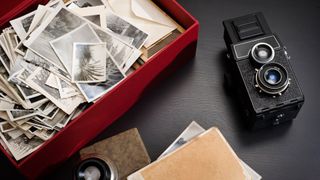If your home is filled with old photographs that you’ve now digitized, you may be wondering: can photos be recycled? After all, throwing them away isn’t particularly green, especially as they contain plastics and chemicals, which can be harmful to the environment. While older photos may have a similar look and feel to the kind of glossy paper you see in the magazines that you regularly recycle, the short answer is that, no, old photos cannot be recycled by conventional methods. Don’t put them in your recycling bins.
However, this only applies to older photos, negatives, and films. Modern photos, printed on recyclable paper from a DSLR camera or mirrorless camera, are things you can recycle as they don’t contain the same chemicals and plastics as images used in the older, more traditional photographic process.
Waste disposal experts warn that anyone attempting to recycle old photographs, which were produced using the traditional photographic process (created by developing light sensitive film), will be unable to do so because the chemicals interfere with the production of recycled paper. Things like acetic acid, gelatin emulsion, and silver halide compounds can be found in glossy photos, and these are not materials that can be recycled. If you want a full list… this is a great article on the subject.
Similarly, negatives and slides are made out of plastics with other chemicals mixed in, and therefore cannot be recycled with either the paper or the plastic waste that your house generates.

What kind of photos can be recycled?
If your photos are more modern, there’s a good chance that they can be recycled. Anything printed on regular, non-glossy paper is fine. Similarly, if you’ve had photobooks or photocards produced with your images, these should all be widely recycled too. For anyone who has printed out photos at home, it all depends what type of photo paper you used. Many modern photo papers can be recycled, and come from sustainable sources, so you’re doubling your eco dollar here. If you’re in doubt, check with the manufacturer of whatever paper you bought.
If you got your photos printed at one of the best photo prints services online, many of these companies have started to use photo paper that can be recycled, although again you should check with the printer before you throw the photos into your recycling bin.
Many one-hour photo processing stores have moved on from older, non-recyclable paper, but some do still use the older methods. You’ll also find that some professional photographers, who still work with film-based cameras to perform things like school photos or family portraits, will also produce the older style images.

How can you tell if a photo can be recycled?
While it’s not a 100% foolproof method, one way to test your photo is to simply tear it in half. If the rip is clean, and the photo separates into two even pieces, it’s usually fine to be recycled. It’ll feel like thick, glossy paper like the cover of a magazine. However, if you find it more difficult to rip, and it has noticeable layers (like a glossy plastic coating) then it’s an older photograph, and cannot be recycled. You can usually tell the difference - there’s a kind of stretchy feel to older photos, when you try to rip them in half. Yes, this is a destructive test, but hey - you wanted to recycle them anyway, right?
How can you dispose of old, non-recyclable photos?
The most obvious way to dispose of older photos is to seal them in a bag and put them in the trash. Sure, this works, but it’s not very environmentally friendly - those plastics and chemicals are going to landfill. And if the photographs contain any sensitive information or topics, these can be recovered or exploited by identity thieves.
If you don’t care too much about the environmental impact, we recommend shredding old photos, so you can be sure they have been destroyed. This shredded material can then be trashed as normal. You can burn photographs in fires that are outside the home, but make sure you have a good space for the smoke and fumes to disperse, because old photos and magazines give off some toxic chemicals that can impact your health, and cause damage to interior fires and chimneys. And, again, you’re releasing chemicals into the atmosphere.

We recommend upcycling older photos, if at all possible. If you no longer want old pictures, think about whether your family might want them in some kind of scrapbook or photo frame. Believe it or not, some people actually want old photos as art and craft materials, so it’s possible you’ll find a buyer online, who will give you a few bucks for them.
If you’re determined to go green, there are some companies that specialize in disposing of old photos and old photographic materials in an environmentally advantageous way. Your local authority may also be able to help you dispose of them cleanly too, especially if you have a large number of images and negatives, so give them a call or email to see what options are available to you. This breakdown from CineStillFilm is a good guide for whether or not you need authority assistance. If you have darkroom lab waste, this is something you will need to have cleared for you.

